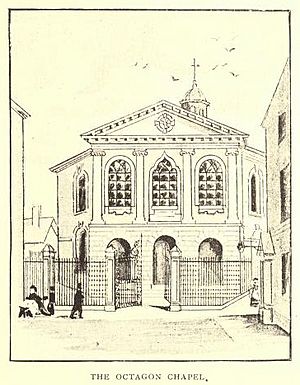Matthew Dobson (physician) facts for kids
Matthew Dobson (1732–1784) was an English doctor and scientist who studied how the body works. He is best known for his important discoveries about diabetes.
Life and Work
Matthew Dobson was born in 1732. His father, Joshua Dobson, was a minister, and his mother was Elizabeth Smith. Matthew went to Glasgow University in 1750 and earned his first degree in 1753. He then studied medicine at Edinburgh University, becoming a doctor in 1756. After finishing his studies, he started working as a doctor in Liverpool.
In 1769, Dobson helped create the Liverpool Academy of Art. This was a local art school, similar to the bigger Royal Academy in London. He also became a doctor at the Liverpool Royal Infirmary in 1770. He even helped write a book about Liverpool's history in 1772.
Around 1776, Dobson stopped working in Liverpool. He became a member of the Fellow of the Royal Society in 1778, which is a very respected group of scientists. In 1780, because of his health, he moved to Bath, Somerset. He also joined the Manchester Literary and Philosophical Society, a group where people discussed science and ideas.
Dobson was the doctor and a close friend to a famous writer named Hester Thrale. He helped her with personal matters, showing how much she trusted him.
Matthew Dobson passed away in Bath on July 25, 1784. He was buried in Walcot.
Medical Study Groups
Dobson was part of a group of doctors who met regularly to discuss medical topics. This group included other important doctors like John Aikin and John Haygarth. Dobson shared information about the influenza (flu) in Liverpool with Haygarth for his research.
This group also worked with scientists like Joseph Priestley. They explored new ideas, such as using different gases for medical treatments.
Dobson's Medical Discoveries
When he was a student, Dobson worked on experiments about evaporation. Later, in 1775, he made a very important discovery about diabetes. He was the first to realize that the sweet substance found in the urine of diabetic patients was actually sugar.
He published his findings in 1776. Dobson also noticed that the blood of people with diabetes tasted sweet, which is caused by too much sugar in the blood (called hyperglycemia). He argued that diabetes was not a problem with the kidneys, as many believed then. His work helped other doctors, like John Rollo, develop special diabetic diets in the late 1790s.
In 1775, Dobson also experimented with using a heated room as a treatment for certain conditions. He published his results in a scientific paper.
In 1779, Dobson found success using "fixed air" (which we now call carbon dioxide) to treat scurvy, a disease caused by a lack of vitamin C. He wrote a book about it. He also suggested using fixed air to treat "the stone," which refers to bladder stones. Dobson was also interested in studying how common bladder stones were in different hospitals.
Family Life
In 1759, Matthew Dobson married Susannah Dobson, who was a translator. They had three children. Dobson also helped build the Octagon Chapel, Liverpool, a special church in Liverpool.


